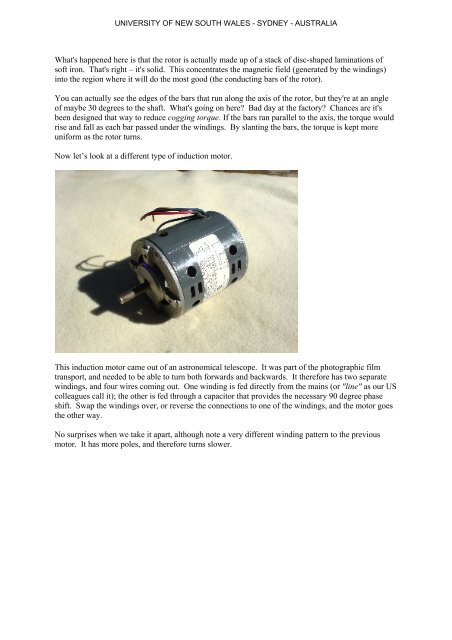How real electric motors work - School of Physics - The University of ...
How real electric motors work - School of Physics - The University of ...
How real electric motors work - School of Physics - The University of ...
You also want an ePaper? Increase the reach of your titles
YUMPU automatically turns print PDFs into web optimized ePapers that Google loves.
UNIVERSITY OF NEW SOUTH WALES - SYDNEY - AUSTRALIA<br />
What's happened here is that the rotor is actually made up <strong>of</strong> a stack <strong>of</strong> disc-shaped laminations <strong>of</strong><br />
s<strong>of</strong>t iron. That's right – it's solid. This concentrates the magnetic field (generated by the windings)<br />
into the region where it will do the most good (the conducting bars <strong>of</strong> the rotor).<br />
You can actually see the edges <strong>of</strong> the bars that run along the axis <strong>of</strong> the rotor, but they're at an angle<br />
<strong>of</strong> maybe 30 degrees to the shaft. What's going on here? Bad day at the factory? Chances are it's<br />
been designed that way to reduce cogging torque. If the bars ran parallel to the axis, the torque would<br />
rise and fall as each bar passed under the windings. By slanting the bars, the torque is kept more<br />
uniform as the rotor turns.<br />
Now let’s look at a different type <strong>of</strong> induction motor.<br />
This induction motor came out <strong>of</strong> an astronomical telescope. It was part <strong>of</strong> the photographic film<br />
transport, and needed to be able to turn both forwards and backwards. It therefore has two separate<br />
windings, and four wires coming out. One winding is fed directly from the mains (or "line" as our US<br />
colleagues call it); the other is fed through a capacitor that provides the necessary 90 degree phase<br />
shift. Swap the windings over, or reverse the connections to one <strong>of</strong> the windings, and the motor goes<br />
the other way.<br />
No surprises when we take it apart, although note a very different winding pattern to the previous<br />
motor. It has more poles, and therefore turns slower.
















